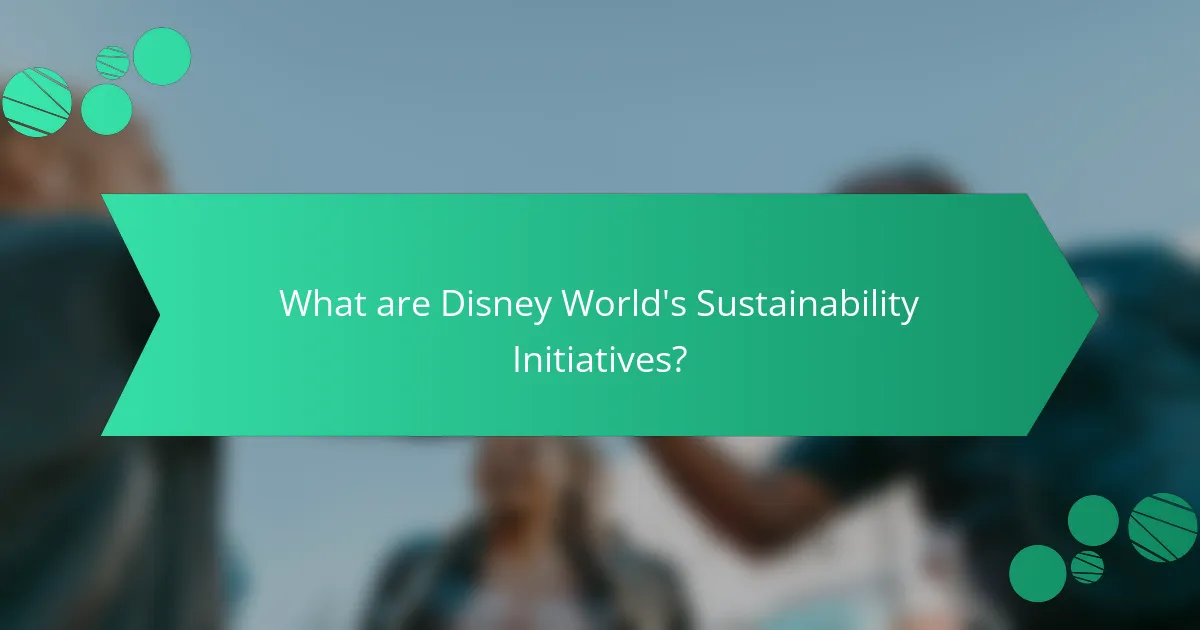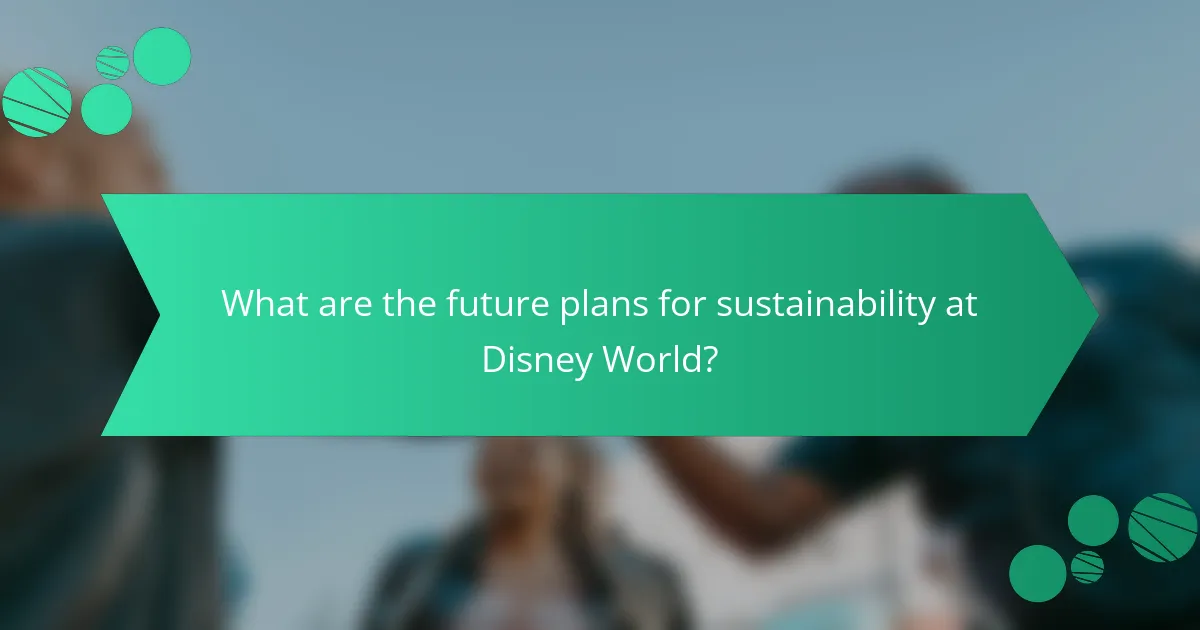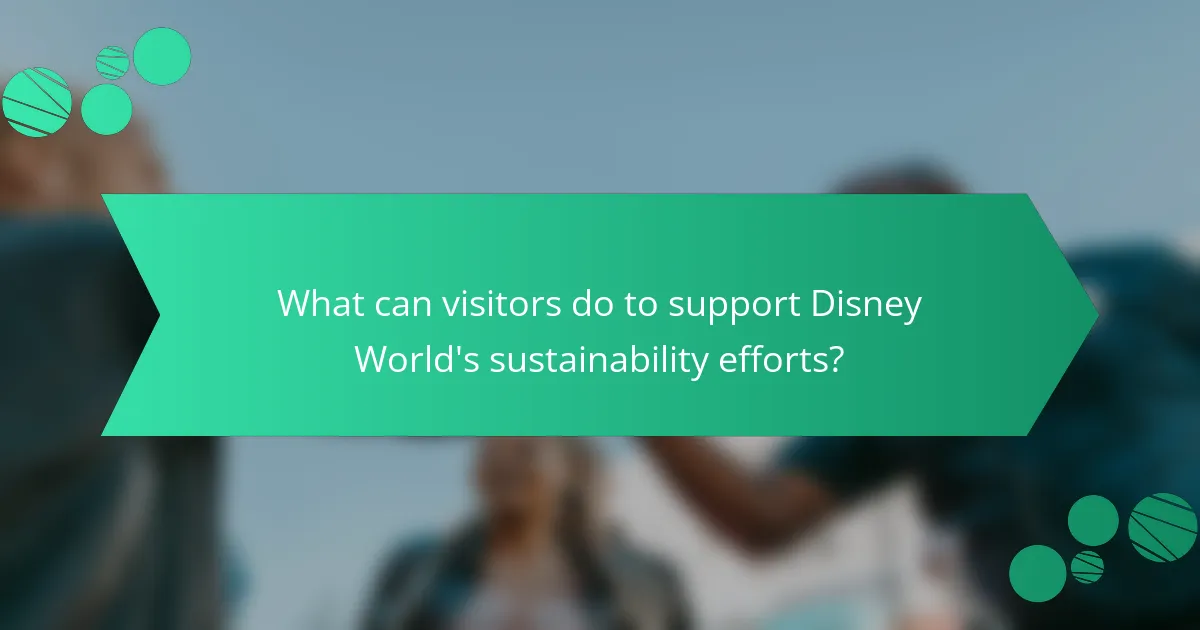
What are Disney World’s Sustainability Initiatives?
Disney World’s sustainability initiatives focus on reducing environmental impact and promoting conservation. The resort aims to achieve net zero greenhouse gas emissions by 2030. Disney has implemented water conservation measures, reducing water usage by 30% since 2005. The parks utilize solar energy, with a solar facility generating 50 megawatts of power. Waste diversion efforts include recycling and composting, diverting over 60% of waste from landfills. Disney also engages in wildlife conservation, supporting various species through habitat restoration projects. Community outreach programs educate guests about sustainability practices. These initiatives reflect Disney’s commitment to environmental stewardship.
How do these initiatives align with global sustainability goals?
Disney World sustainability initiatives align with global sustainability goals by reducing environmental impact and promoting community well-being. These initiatives focus on energy efficiency, waste reduction, and water conservation. For instance, Disney aims to achieve net zero greenhouse gas emissions by 2030. The company has implemented solar energy projects, which contribute to clean energy usage. Additionally, Disney engages in responsible sourcing and conservation efforts, supporting biodiversity. These actions support the United Nations Sustainable Development Goals, particularly Goal 7 (Affordable and Clean Energy) and Goal 12 (Responsible Consumption and Production). By promoting eco-friendly practices, Disney contributes positively to global sustainability efforts.
What specific sustainability goals does Disney World aim to achieve?
Disney World aims to achieve several specific sustainability goals. These include reducing greenhouse gas emissions by 50% by 2020, achieving zero waste to landfills at its parks and resorts, and conserving water by reducing consumption by 15% per capita by 2020. Additionally, Disney World focuses on sourcing sustainable seafood and supporting responsible forestry practices. The company has also committed to reducing single-use plastics across its operations. These goals align with Disney’s broader environmental stewardship strategy, which emphasizes conservation and community engagement.
How is Disney World measuring its progress in sustainability?
Disney World measures its progress in sustainability through various metrics and initiatives. The resort tracks energy consumption, water usage, and waste diversion rates. It aims for a zero waste goal by diverting 90% of its waste from landfills. Disney also monitors greenhouse gas emissions to reduce its carbon footprint. The company reports on these metrics annually in its sustainability report. This report includes specific data, such as a 50% reduction in greenhouse gas emissions since 2012. Additionally, Disney engages in community partnerships to enhance its sustainability efforts. These measures reflect Disney’s commitment to environmental stewardship and accountability.
What eco-friendly practices are implemented at Disney World?
Disney World implements several eco-friendly practices to promote sustainability. The resort utilizes solar energy, with a solar facility generating up to 50 megawatts of power. Waste reduction is prioritized, with a goal of diverting 90% of waste from landfills. Disney World also emphasizes water conservation, using advanced irrigation systems to reduce water usage by 20%. The park features electric transportation options, including buses and boats, to minimize emissions. Additionally, Disney engages in habitat conservation efforts, protecting local wildlife and ecosystems. These initiatives reflect Disney’s commitment to environmental stewardship and sustainability.
What types of renewable energy sources does Disney World use?
Disney World utilizes solar energy and wind energy as renewable sources. The resort has installed a large solar facility that generates up to 50 megawatts of electricity. This solar energy contributes significantly to the park’s overall power needs. Additionally, Disney World has invested in wind energy through partnerships that support wind farms. These initiatives align with Disney’s commitment to sustainability and reducing carbon emissions.
How does Disney World manage waste and recycling?
Disney World manages waste and recycling through a comprehensive waste management program. The program includes waste reduction, recycling, and composting initiatives. Disney World aims to divert 60% of its waste from landfills. The park utilizes recycling bins strategically placed throughout the property. These bins are clearly labeled for easy public use. In 2020, Disney World recycled over 1.2 million pounds of materials. The park also composts organic waste from food services. This composting process supports local agriculture and enhances soil health. Overall, Disney World’s efforts contribute to its sustainability goals and environmental stewardship.
What role does community engagement play in Disney World’s sustainability efforts?
Community engagement is crucial to Disney World’s sustainability efforts. It fosters collaboration with local organizations and stakeholders. Disney actively involves the community in environmental initiatives. Programs include volunteer opportunities and educational workshops. These initiatives raise awareness about sustainability. Community feedback informs Disney’s sustainability strategies. This collaboration enhances the effectiveness of their eco-friendly practices. Engaging the community ensures that sustainability efforts are relevant and impactful.
How does Disney World involve local communities in its initiatives?
Disney World involves local communities through partnerships and programs that promote community engagement. The Walt Disney Company collaborates with local organizations to support education, conservation, and cultural initiatives. For instance, Disney’s Conservation Fund grants support local environmental projects. Additionally, Disney offers volunteer opportunities for community members through events like the “Disney VoluntEARS” program. This program encourages employees and local residents to participate in community service. Disney also engages with local schools by providing educational resources and programs that focus on sustainability. These initiatives demonstrate Disney’s commitment to fostering positive relationships with the surrounding communities.
What educational programs does Disney World offer related to sustainability?
Disney World offers several educational programs focused on sustainability. One key program is the “Disney Conservation Fund,” which supports various conservation initiatives. Another program is “Wildlife Wednesdays,” an educational series that highlights animal conservation efforts. Additionally, Disney provides hands-on experiences through “Nature-Based Learning” programs for students. These programs teach about ecosystems and conservation practices. Disney also collaborates with local schools for educational field trips centered on environmental stewardship. The “Epcot International Flower & Garden Festival” includes sustainability-focused workshops and demonstrations. These initiatives reflect Disney’s commitment to environmental education and sustainability.

What are the future plans for sustainability at Disney World?
Disney World plans to enhance sustainability through several initiatives. The resort aims to reduce greenhouse gas emissions by 50% by 2020, relative to 2012 levels. Disney intends to achieve net zero emissions by 2030. The company is also focusing on water conservation, aiming to reduce water consumption by 15% by 2020. Additionally, Disney is investing in renewable energy sources, with a goal of powering its operations with 100% renewable energy by 2022. The park plans to eliminate single-use plastics in its parks and resorts by 2021. Disney is committed to wildlife conservation and habitat preservation as part of its sustainability efforts. These plans reflect Disney’s dedication to environmental stewardship and community responsibility.
How is Disney World planning to enhance its sustainability initiatives?
Disney World is planning to enhance its sustainability initiatives by implementing various eco-friendly practices. The resort aims to reduce greenhouse gas emissions by 50% by 2020 compared to 2012 levels. It is investing in renewable energy sources, such as solar power, to achieve this goal. Additionally, Disney World is focusing on reducing water consumption through advanced irrigation systems. The park is also enhancing waste management by increasing recycling efforts and reducing single-use plastics. These initiatives are part of Disney’s broader commitment to environmental stewardship and sustainable operations.
What upcoming projects are in the pipeline for eco-friendly practices?
Disney World has several upcoming projects focused on eco-friendly practices. These include the expansion of solar energy initiatives across the park. A new solar facility is set to increase renewable energy generation. Additionally, Disney plans to enhance waste reduction efforts through improved recycling programs. They aim to eliminate single-use plastics in dining areas by 2022. Furthermore, the park is investing in wildlife conservation projects to protect local ecosystems. These initiatives align with Disney’s commitment to achieving net-zero greenhouse gas emissions by 2030.
How does Disney World plan to adapt to future environmental challenges?
Disney World plans to adapt to future environmental challenges through a comprehensive sustainability strategy. The strategy includes reducing greenhouse gas emissions by 50% by 2020 from 2006 levels. Disney World is investing in renewable energy sources, including solar power, to meet its energy needs. The theme park has already installed solar panels that generate significant electricity. Additionally, Disney World aims to minimize water usage by implementing advanced irrigation systems and water recycling programs. The park also focuses on waste reduction, with a goal of sending zero waste to landfills by 2030. These initiatives are part of Disney’s broader commitment to environmental stewardship and sustainability.
What partnerships is Disney World forming to advance sustainability?
Disney World is forming partnerships with various organizations to advance sustainability. They are collaborating with the Disney Conservation Fund to support wildlife conservation efforts. Additionally, Disney has partnered with the Nature Conservancy to promote forest conservation and sustainable practices. They are also working with local governments and environmental groups to enhance community engagement in sustainability initiatives. These partnerships aim to reduce waste and promote renewable energy sources. Disney World has committed to achieving net-zero greenhouse gas emissions by 2030. This goal is supported by their partnerships and ongoing sustainability projects.
Which organizations is Disney World collaborating with for sustainability initiatives?
Disney World is collaborating with organizations such as the Nature Conservancy and the World Wildlife Fund for sustainability initiatives. These partnerships focus on conservation efforts and environmental protection. The Nature Conservancy aids in habitat restoration projects. The World Wildlife Fund supports wildlife conservation and sustainable practices. Disney’s commitment to sustainability is evident in these collaborations.
How do these partnerships impact community engagement and eco-friendly practices?
Partnerships enhance community engagement and promote eco-friendly practices at Disney World. These collaborations often involve local organizations focused on sustainability. For instance, partnerships with environmental groups help implement conservation programs. They engage the community through educational initiatives and volunteer opportunities. This involvement fosters a sense of ownership among residents. Additionally, eco-friendly practices are amplified through shared resources and expertise. Collaborations lead to innovative solutions for waste reduction and energy efficiency. Disney’s commitment to sustainability is reflected in its community-driven projects. These initiatives demonstrate the positive impact of partnerships on both engagement and environmental stewardship.

What can visitors do to support Disney World’s sustainability efforts?
Visitors can support Disney World’s sustainability efforts by participating in recycling programs. They can use designated recycling bins located throughout the parks. Visitors should also minimize single-use plastics by bringing reusable water bottles. This aligns with Disney’s initiative to reduce plastic waste by 50% by 2030. Using public transportation or Disney’s transportation services can help decrease carbon emissions. Additionally, guests can choose to dine at restaurants that prioritize local and sustainable sourcing. Engaging in educational programs about conservation can further enhance awareness of sustainability practices. Disney encourages guests to share their sustainability efforts on social media, promoting a culture of eco-friendliness.
How can guests contribute to sustainability while visiting Disney World?
Guests can contribute to sustainability while visiting Disney World by practicing responsible behaviors. They can reduce waste by using reusable water bottles and containers. Guests should also recycle items in designated bins throughout the parks. Utilizing Disney’s transportation options, like buses and the monorail, helps decrease carbon emissions. Choosing plant-based meal options supports sustainable food practices. Participating in conservation programs, such as tree planting events, enhances local ecosystems. Additionally, guests can support eco-friendly merchandise sold in the parks. These actions align with Disney’s commitment to sustainability and environmental stewardship.
What are some best practices for eco-friendly behavior at Disney World?
To practice eco-friendly behavior at Disney World, guests should utilize reusable water bottles. This reduces plastic waste significantly. Guests can also use the park’s recycling bins to dispose of waste properly. Opting for plant-based meals supports sustainable food practices. Walking or using public transportation reduces carbon footprints while exploring the park. Participating in park-wide conservation programs enhances environmental awareness. Disney World has committed to reducing greenhouse gas emissions by 50% by 2020, demonstrating its dedication to sustainability.
How can visitors participate in Disney World’s community engagement programs?
Visitors can participate in Disney World’s community engagement programs by volunteering for local initiatives. Disney offers various opportunities for guests to assist in environmental conservation efforts. Programs include park clean-ups and tree planting events. Visitors can also join educational workshops focused on sustainability. Additionally, Disney encourages participation through social media campaigns. Guests can share their experiences and promote community events online. These initiatives foster a sense of community involvement and awareness. Disney collaborates with local organizations to enhance engagement opportunities.
Disney World is the primary entity discussed in this article, focusing on its sustainability initiatives aimed at reducing environmental impact and promoting conservation. Key information includes Disney’s goals of achieving net zero greenhouse gas emissions by 2030, implementing water conservation measures, utilizing solar energy, and engaging in wildlife conservation. The article also highlights the significance of community engagement and educational programs in supporting sustainability efforts. Additionally, it outlines future plans and partnerships that enhance Disney’s commitment to eco-friendly practices and responsible resource management.